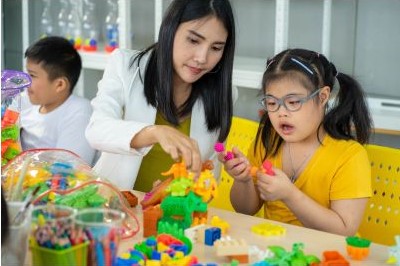We’ve been talking a lot about autism lately, and I think it’s so important to have a deeper understanding of how autism impacts kids in school—and more importantly, how we can create environments where they can truly thrive. You know, autism is a spectrum, which means every kid experiences it differently. Some may have difficulty with communication, others may excel in certain areas like math or art, and some might have sensory sensitivities that can make typical classroom settings tough.
Understanding all of this can really change the way we approach education for kids on the spectrum. It’s about meeting them where they are and providing the right tools to help them learn and grow in their own unique way.
Let’s break this down a bit more in depth:
1. Sensory Sensitivities and Creating a Comfortable Learning Environment
As I mentioned earlier, sensory sensitivities are a huge factor for many children on the spectrum. The world can sometimes feel overwhelming, and this sensory overload can interfere with a child’s ability to focus and learn effectively. In a typical classroom, there are all kinds of sensory distractions: buzzing lights, the hum of computers, chatter, movement, even the feel of certain materials. For a child with autism, these sensory inputs might be more intense and harder to filter out.
Practical Strategies:
- Flexible Seating Options: Allowing children to choose where they sit—whether it’s in a quiet corner, at a standing desk, or with a fidget tool—can help them regulate their sensory input. Some kids do better with soft lighting, so using natural light or desk lamps instead of overhead fluorescent lights could reduce stress.
- Sensory Breaks: Introducing short, structured breaks during the day can also be helpful. After a period of focused work, a quick walk or access to a sensory tool (like a stress ball or textured fabric) can help the child reset and re-engage with the lesson.
- Noise-Canceling Headphones: For kids who are sensitive to sound, offering noise-canceling headphones during group activities or independent work time can be a game-changer.
- Calming Tools: Fidget toys, weighted blankets, or even a “calm-down” corner with pillows and soft materials can be a refuge when things get overwhelming.
By adjusting the classroom environment to accommodate these sensory needs, we can help kids with autism feel more comfortable, focused, and ready to engage in learning.
2. Routine, Structure, and Predictability
Kids with autism often feel more secure and capable when there’s a clear structure to their day. Having a consistent routine helps reduce anxiety, making transitions between activities smoother. This is especially important because kids on the spectrum may struggle with unexpected changes, and sudden disruptions can cause stress or frustration.
Practical Strategies:
- Visual Schedules: One of the most effective tools for providing structure is a visual schedule. This might be a large board with pictures that show what’s coming up in the day—math class, recess, lunch, etc. It’s a great way to provide both predictability and visual support for those who may have trouble with verbal instructions.
- Transitions: Transitions from one activity to another (like moving from reading to math) can be particularly challenging. A transition warning—such as a five-minute timer or a verbal cue—can give kids a heads-up and prepare them for what’s coming next.
- Clear, Simple Instructions: Instead of saying, “Please finish your work,” try something more specific, like, “Please write the date at the top of your paper, then read the first question and answer it.” This helps clarify the task and removes any confusion or ambiguity that might arise.
By creating a predictable environment, kids with autism can focus less on the “unknowns” and more on the learning process itself.
3. Leveraging Visual Supports and Technology
As I mentioned, visual supports are a huge help. Many children with autism are visual learners, so offering information in a visual format can make tasks feel more manageable. Plus, it can help them remember and understand what’s being taught in a more concrete way.
Practical Strategies:
- Picture Exchange Communication System (PECS): For non-verbal children, PECS is a system that uses pictures to communicate basic needs, emotions, or actions. It’s a way of giving kids a voice when they struggle with verbal language.
- Interactive Whiteboards or Tablets: Technology can also be a fantastic support tool. Tablets or apps that allow kids to interact with the content (through drawing, matching, or video lessons) can engage them in a more dynamic way. Some apps even help with things like speech and language development or social skills training.
- Task Cards: Breaking down complex tasks into smaller steps using task cards—visual cards with one instruction per card—helps children with autism focus on one task at a time and feel accomplished after completing each step.
- Social Stories: Social stories are a visual storytelling technique that can help children understand social situations and expected behaviors. They’re especially helpful for teaching social norms, like how to greet a peer or how to wait for your turn. Social stories provide a concrete, step-by-step example of what a specific social interaction might look like, which is incredibly helpful for kids who struggle with social cues.
By using these visual supports, we make learning more accessible and less overwhelming for children with autism, helping them to navigate the classroom environment more easily.
4. Social Skills Development
Social interaction is often one of the most difficult areas for children with autism. They may find it hard to make friends, understand the nuances of communication, or know how to express themselves in social settings. However, just like academic skills, social skills can be taught and improved with practice and patience.
Practical Strategies:
- Role-Playing: A great way to teach social skills is through role-playing exercises. For example, you can practice what it looks like to greet someone, how to ask a question in a group, or how to participate in a conversation. The more practice kids get in a safe and controlled setting, the more confident they’ll feel when the time comes to use those skills in real-life situations.
- Peer Buddies: Having a peer buddy—someone who is patient and understanding—can provide both social support and a model for appropriate behavior. It’s great for developing friendships and helping kids feel included, and the buddy system also gives kids a sense of responsibility and pride.
- Structured Play: In some schools, structured play activities can be incorporated to help kids with autism learn how to play with others in a social context. Activities like cooperative games, group projects, or even structured recess time (like organized games with a clear structure and rules) can give kids a chance to practice social interactions in a more manageable way.
5. Focusing on Strengths and Interests
As much as we focus on addressing areas of difficulty, it’s equally important to play to a child’s strengths and interests. Every child, including those on the autism spectrum, has unique talents and passions that can be harnessed to make learning engaging.
Practical Strategies:
- Interest-Based Learning: If a child is passionate about trains, dinosaurs, or space, why not use that interest to help them learn? You can incorporate their favorite topics into lessons on math (counting train cars), reading (reading books about dinosaurs), or even writing (writing a story about a space adventure). When kids are emotionally invested in the content, they’re more likely to stay engaged and motivated.
- Strength-Based Activities: Some children may be highly skilled in areas like art, technology, or music. Encouraging these strengths not only boosts their confidence but can also be a gateway to academic learning. A child who loves drawing may use their artistic skills to create a project or visual representation of what they’re learning in history or science.
By encouraging a child’s interests and strengths, we help them feel competent and valued—this is key to boosting self-esteem and motivation.
6. Encouraging Independence and Self-Advocacy
Building independence is a big part of helping children with autism succeed in school. As they grow, learning to manage their own tasks and emotions is crucial for both academic success and life skills.
Practical Strategies:
- Task Chaining: Task chaining is a technique where you break a task down into smaller, manageable steps, and the child learns each step in sequence. For example, if a child is learning how to pack their school bag, you might break the task into steps like: “Put your lunchbox in the bag,” “Put your pencil case in the bag,” etc. Gradually, they learn to do the whole task independently.
- Self-Regulation Tools: Providing kids with tools to regulate their emotions—such as deep breathing exercises, stress-relief toys, or even a visual chart showing different emotions and coping strategies—helps them manage frustration or anxiety without needing to rely on others to intervene.
- Self-Advocacy Skills: As kids get older, it’s important to teach them how to advocate for themselves. This could be as simple as learning how to ask for help when they’re stuck, how to request a break when they’re overwhelmed, or how to communicate their needs clearly to teachers and peers.
7. Collaboration Between Educators, Parents, and Therapists
Creating a supportive environment for children with autism isn’t something that can be achieved by a single person or team alone. It requires constant collaboration between teachers, parents, therapists, and sometimes specialists such as speech-language pathologists or occupational therapists. The more open and consistent the communication is, the better the child’s chances of thriving both academically and socially.
Practical Strategies:
- Regular Communication: A key element in successful collaboration is establishing a regular feedback loop. Teachers can share updates on the child’s progress in the classroom, while parents can offer insight into what’s working (or not working) at home. Having consistent check-ins—whether through emails, meetings, or phone calls—helps everyone stay on the same page and make necessary adjustments.
- Individualized Education Plans (IEPs): One of the most important tools in supporting a child with autism is an IEP, which outlines specific goals, accommodations, and modifications that will help the child succeed in school. This plan is tailored to the child’s unique needs and is updated regularly to reflect progress and any changes in their development.
- Therapeutic Support: Many children with autism also benefit from additional support outside of school. Occupational therapy can help with fine motor skills or sensory processing, while speech therapy can improve communication. By working with therapists who specialize in autism, parents and teachers can integrate strategies from these disciplines into daily classroom activities.
- Creating a Support Network: Collaboration isn’t limited to just one or two professionals. A child with autism benefits when there is a whole team involved—teachers, special education staff, therapists, and family members—who all have a shared understanding of the child’s needs and how best to meet them. This holistic approach ensures that the child receives support in all areas of their life, from home to school to extracurricular activities.
8. Fostering Emotional Well-Being and Mental Health
Emotional well-being is crucial for everyone, but it’s especially important for children with autism, who may experience heightened anxiety, depression, or frustration due to their challenges with communication, socializing, and processing sensory information. A big part of supporting them in school is acknowledging their emotional needs and providing the necessary support to manage these feelings.
Practical Strategies:
- Emotional Regulation Tools: Helping children with autism recognize and manage their emotions is key to supporting their mental health. Teachers can incorporate emotional regulation strategies like deep breathing, mindfulness, or grounding exercises into the daily routine. For example, teaching a child how to identify their feelings (using a feelings chart) and then choose a coping strategy (like taking a break or doing breathing exercises) can help them gain more control over their emotions.
- Stress-Reduction Techniques: Children with autism often struggle with anxiety. A calming routine, such as listening to soothing music or using weighted blankets during quiet time, can help them manage stress. It’s also important to recognize when a child is starting to feel overwhelmed and to provide early intervention—like offering them a quiet space to decompress before they become too upset.
- Building Resilience: A part of fostering emotional well-being is teaching children how to cope with failure or disappointment. It’s important to create an environment where making mistakes is seen as a normal part of learning, not something to be afraid of. Encouraging a growth mindset—where effort is valued over perfection—helps children with autism build resilience and self-esteem.
- Positive Reinforcement: Providing positive reinforcement for small steps of progress can have a huge impact. This isn’t just about rewarding academic achievements but also about acknowledging emotional or social milestones. For example, if a child with autism successfully asks a peer to play or calmly deals with frustration, that should be celebrated. Recognizing these achievements encourages the child to keep building those skills.
9. Inclusive Education and Peer Relationships
While individualized strategies are important, fostering inclusive education—where children with autism are integrated into the general classroom as much as possible—can help reduce feelings of isolation and give them the opportunity to develop peer relationships. Creating an inclusive classroom means encouraging respect, understanding, and acceptance among all students, regardless of their abilities.
Practical Strategies:
- Peer Education and Awareness: One way to foster inclusion is by educating neurotypical peers about autism in an age-appropriate way. When children understand that a peer may have different ways of communicating or processing information, they’re more likely to be empathetic and inclusive. This could be done through activities or lessons that teach kids about neurodiversity and the importance of accepting differences.
- Buddy Systems: Pairing a child with autism with a supportive peer can create both social and academic opportunities. A peer buddy can help guide them through the day, explain tasks, and provide emotional support during group activities. This not only benefits the child with autism but also helps foster empathy and leadership skills in the peer.
- Social Inclusion: Ensure that the child with autism has access to social activities like recess, group projects, and even extracurriculars. While some children may need extra support or accommodations, being part of group activities helps them practice social skills and feel included in the classroom community.
- Promoting Positive Peer Interactions: Teachers can help facilitate positive social interactions by setting up structured group activities where every child is encouraged to participate. Activities that require cooperation, like group art projects or collaborative problem-solving tasks, can help kids on the autism spectrum practice social skills in a less overwhelming context.
10. Building Transitions from School to Post-School Life
The transition from school to post-school life (whether it’s transitioning from elementary to middle school, or preparing for life after high school) is an important but often overlooked part of autism support. Planning ahead and preparing for these transitions can make a big difference in helping children with autism feel more confident and capable in the next phase of their lives.
Practical Strategies:
- Transition Planning: For older students, it’s essential to create a transition plan that addresses not just academic goals, but also social, emotional, and vocational goals. This might include helping students develop job skills, teaching independent living skills (like cooking or managing money), and providing guidance on higher education or vocational training.
- Career Exploration: Helping students with autism explore their interests and potential career paths is crucial for building a future. Some students may be interested in technical fields, while others may excel in creative arts or sciences. Schools can offer career exploration programs that help students gain hands-on experience in areas they might be interested in, whether through internships, job shadowing, or volunteer work.
- Life Skills Training: As part of the transition process, teaching life skills—such as cooking, time management, self-care, and communication—is essential for building independence. These skills might be taught in specialized classrooms, but it’s also helpful to integrate them into the child’s daily routine, providing real-life practice in a safe and supportive environment.
- Support Beyond School: Once a child leaves school, they may need ongoing support in terms of employment, social relationships, and mental health. Parents and caregivers can connect with community programs, job coaches, or adult services that specialize in helping individuals with autism navigate life after school.

So, after all this, I think the core message is this: supporting kids with autism in education isn’t about “fixing” them; it’s about recognizing their unique needs, abilities, and ways of learning and giving them the tools to succeed. Whether it’s providing sensory accommodations, using visual supports, fostering social skills, or creating an inclusive environment, every small adjustment can have a massive impact.
It’s also about seeing the whole child—not just focusing on challenges but celebrating their strengths, interests, and potential. The more we build an understanding of how autism works in an educational setting, the more we can create environments where every child, no matter where they fall on the spectrum, can feel supported, seen, and successful.
And if we get it right—if we create a school system that’s inclusive, flexible, and compassionate—those kids will not only thrive in school, but they’ll carry those skills and the confidence they’ve gained into adulthood. It’s about giving them a foundation for lifelong success, one where they can reach their full potential, whatever that may look like.
I really believe this is something that everyone—teachers, parents, and communities—can work together on. It’s not always easy, but when we come together to support these kids, we can make a huge difference in their lives.
What are your thoughts? Does any of this resonate with what you’ve seen or experienced? I think when it comes to autism and education, the more we talk about it, the more awareness we raise, and the better we can create meaningful change.







